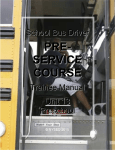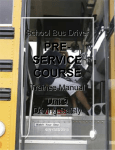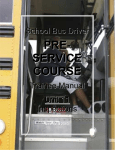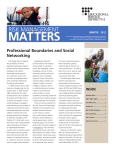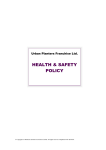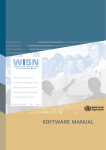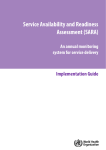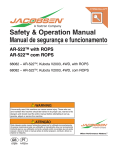Download Pre-Service Course Trainee Manual
Transcript
School Bus Driver PRESERVICE COURSE Trainee Manual Unit 12 Wheelchairs © ©N NY YS SE ED D 22001100 New York State School Bus Driver Pre-Service Manual Unit 11 p. 1 This page intentionally left blank. New York State School Bus Driver Pre-Service Manual Unit 12 p. 2 Acknowledgements We could not have prepared this curriculum without the ideas, enthusiasm, and guidance of the following people: Marion Edick, State Director of Pupil Transportation NYSED SBDI Advisory Committee: Jim Brown, Robert Brown, Jason Burrick, Jorge DeJesus, Lorraine Misciagno, Susan Soudant, Faye Stevens, Peter Brockmann, Betty Hughes, Patricia Martell, Paul Mori, Chuck Paquette, Joseph Van Aken, Patricia Bailey, Lenny Bernstein (chair), Ted Finlayson-Schueler, Kathy Furneaux, Peter Lawrence, Peter Montalvo, James Rogan, and Maureen Ryan Safety Rules! Curriculum Advisory Committee: Lance Frieberger, Cliff Berchtold, Joe Van Aken, Paul Mori, Mike Dello Ioio, Faye Waxman, Robin Parks, Teena Fitzroy, Deanna Adams, Peter Lawrence, Deb Stevens, Greg Jenne, and Judy Clarke Moravia CSD School Bus Drivers, Attendants, and Mechanics Attendees at Syracuse focus group: Tyronne Worrell, Luther Everson, Cindy Raulli, Deb Lilley, Deb Stevens, Tammy Payne, Chuck Paquette, Barb Biddlecome, Terri Kuss, Shelly O’Riley, and Pat Bailey Attendees at Rochester focus group: Peter Lawrence, Michael Proukou, and Kitty Rhow Lee Comeau, retired, author of the original (1989) Pre-Service Course - JE & TFS, June, 2010 Title: School Bus Driver Pre-Service Course – Trainee Manual Unit 12 Authors: Jim Ellis and Ted Finlayson-Schueler Copyright June 30, 2010 The University of the State of New York The New York State Education Department Office of Pupil Transportation Unit EBA, Room 876 Albany, NY 12234-0001 Phone: (518) 474-6541 • Fax: (518) 474-1983 New York State School Bus Driver Pre-Service Manual Unit 12 p. 3 INTRODUCTION Welcome, new New York State school bus driver! The School Bus Driver Pre-Service Course has one goal: to prepare you to safely transport children on a school bus. You are entering a proud profession. New York State’s school bus drivers have established an admirable safety record over the past generation. Statistically, New York’s school buses represent the safest form of ground transportation ever devised. Children riding in school buses are approximately 24 times safer than when they’re riding in the family car! However, student safety is never assured. Your responsibility for safety will be serious from the first day you drive a bus with children on board. What you learn in this course can save a child’s life. This Trainee Manual will prepare you for the course. Read it carefully before the course begins. Complete the review questions at the end of each Unit before you come to class. Write down any questions you have for your instructor. If you don’t understand something, say so. Asking questions is one sign of a professional. Again, welcome to our New York State school bus safety community! Marion Edick New York State Education Department State Director of Pupil Transportation New York State School Bus Driver Pre-Service Manual Unit 12 p. 4 OPTIONAL UNIT 12: TRANSPORTING STUDENTS USING WHEELCHAIRS Unit 12 Topics 12.1 Types of Mobility Devices 12.2 Using the Wheelchair Lift 12.3 Securement 12.4 TLC 12.5 Evacuation Planning 12.6 Unit 11 Review Introduction Many children use wheelchairs to get around. Wheelchairs and other types of mobility devices provide children with physical disabilities the opportunity to participate fully in school and school activities. Safe transportation of children using wheelchairs demands exceptional attention to detail. A lapse of attention while loading or securing a student using a wheelchair could result in a spill and, possibly, a serious injury to the child. This unit will teach you how to use a wheelchair lift and how to secure a wheelchair and its student passenger in a school bus. You will also learn how and why to practice “TLC driving” when transporting children with orthopedic disabilities. 12.1 Types of Mobility Devices 12.1.1 Older wheelchairs. A generation ago, almost all wheelchairs were “hospital” type chairs. This traditional wheelchair design features large rear wheels and smaller front wheels, a tubular folding frame, removable foot pegs and arm rests, a fabric seat, and no securement belt for the passenger. Special care must be taken when transporting a student using an older hospital-type chair. While hospital wheelchairs are familiar to most people and are still in use by both adults and children, they were not originally intended for transporting on vehicles. Special care must be taken when transporting a student using an older hospital-type chair. Selecting the appropriate “securement points” on the chair frame takes careful consideration. Some areas on the frame of older designs may not be strong enough to keep the chair secure in a crash. Specific guidelines for selecting appropriate securement points are included in Section 12.3 below. Hospital type wheelchairs are often used as back-ups when a child’s more modern personal chair is being serviced. New York State School Bus Driver Pre-Service Manual Unit 12 p. 5 “Loaner” wheelchairs are not always in the best condition: heel spokes may be broken or bent, foot or arm rests or hand grips may be loose or missing altogether, and brakes may not hold the chair. 12.1.2 Modern Wheelchairs. Hundreds of different types of wheelchairs are in use today. To better meet the needs of children, mobility devices are constantly being changed and improved. alleviate breathing problems; tilting forward may help with swallowing difficulties. Passengers in tilt-in-space chairs should ride with the backrest positioned at an angle of 30 degrees or less from vertical. Ask your supervisor for advice if you encounter a child who needs to be tilted back further than that – it may be necessary to move the shoulder belt anchor point rearward so the belt maintains contact with the child’s shoulder and chest. Hundreds of different types of wheelchairs are in use today. Common types of modern mobility devices include: • Transit chairs. Unlike traditional hospital wheelchairs, transit-style mobility devices are intentionally engineered to be transported on a vehicle, including a school bus. Transit chairs are much stronger than traditional hospital chairs. In compliance with a national wheelchair safety design standard known as “WC-19”, transit chairs are designed to remain intact and protect their passengers in a crash. Appropriate securement points are clearly designated by the chair manufacturer. “D-rings” are usually provided for attaching securement straps. If D-rings are present, use them. They represent the safest securement points for that chair. • “Tilt-in-space” mobility devices. Chairs with adjustable passenger frames accommodate children with physical or medical problems who require frequent repositioning of the seat. Tilting a child back may Tilt-in-space chairs can be tricky to secure. On older tilt-in-space chairs, securement straps should be attached to the main wheelchair frame, not the tiltable passenger portion of the device. If the straps were secured to the tiltable passenger portion in a crash, it could move and the chair could come loose. The main chair frame, which is suitable for attaching securement straps, must be distinguished from the tiltable passenger seat portion, which isn’t. • Power wheelchairs. Batterypowered mobility devices provide wonderful independence for the user. However, they can be very difficult to load and secure on a school bus. Appropriate New York State School Bus Driver Pre-Service Manual Unit 12 p. 6 securement points may be difficult to access on older power chairs. (Your supervisor, an SBDI, or the child’s occupational therapist may be able to help locate suitable securement points on powered mobility devices.) A power chair with passenger can weigh several hundred pounds. Additional securement straps may be needed because of the additional weight. Power chairs are usually operated with a joystick-like control. Learn how to operate the steering, accelerator, and brakes. Usually, the child will be proud to show you. 2. Raising/lowering the wheelchair platform that carries the passenger in the wheelchair. Both functions are driven by powerful hydraulic or electrical machinery. An inattentive operator could easily be hurt. Hands are especially vulnerable. A hand (the student’s or the adult operator’s) caught in one of the lifting or folding mechanisms 12.2 Using the Wheelchair Lift 12.2.1 Lifts can be dangerous. Children using mobility devices usually ride on “lift- equipped” school buses. The purpose of the lift is to raise and lower children so they can enter or exit the bus. You need to know how to safely operate a wheelchair lift. Wheelchair lifts must be treated with respect at all times. The stakes are high when operating a lift. Children using wheelchairs have been seriously injured and even killed in accidents involving wheelchair lifts. Bus attendants and bus drivers have also been hurt. There are many different types of wheelchair lifts, but they all share one thing in common: they are complicated pieces of machinery with the potential for injury for anyone not paying careful attention. Wheelchair lifts operate in two stages: 1. Folding/unfolding the platform from its stowed position inside the bus. could be pinched or severed. An operator’s feet could be crushed as the lift platform drops to the ground. Long drawstrings on jackets or sweatshirts, and dangling jewelry or long hair, are dangerous when working with wheelchair lifts. They can get tangled in the lift mechanisms. 12.2.2 Safe lift zone. When approaching a bus stop where a student using a wheelchair will board or exit, stop your bus so the lift is positioned over a safe, level area. The ideal lift zone is a paved surface. Avoid barriers such as curbs or steps. Pull to the right side of the road when stopping to load or unload a student in a wheelchair. Avoid dropping the lift into the roadway. If there’s room to safely pull completely off the road, for instance into a New York State School Bus Driver Pre-Service Manual Unit 12 p. 7 loop driveway or a parking area in a front of the child’s house, do so. It takes much longer to load/unload a child using a wheelchair than it does with ambulatory children. Tying up traffic for several minutes should be avoided if possible. Ask your supervisor or SBDI for guidance about exactly where to make a child’s stop when driving a lift-equipped bus. If the bus stop is in an area with pedestrian traffic, take caution to prevent someone from running into or tripping on the lowered lift platform. 12.2.3 Lift design. There are many types of wheelchair lifts. Controls and safety features vary widely: • • Some lifts won’t run unless the parking brake is set. A safety interlock prevents the bus from being moved when the lift is in use. • Some lifts won’t work unless the engine is running. • Some lifts are equipped with passenger belts, others aren’t. Lifts with passenger belts won’t work unless the belt is latched. • Newer lifts often incorporate additional safety features, such as proximity shut-offs. If anyone is standing too close to the lift machinery, a light beam or sensor plate triggers a kill switch, and the lift won’t operate. Always take the time to learn all the features of the lift you will be using. Don’t be embarrassed to ask a supervisor or a mechanic for an orientation. Most lifts won’t work unless a main lift control is activated. The button is usually 12.2.4 Lift safety procedures. The procedures will prevent an injury to a student or yourself when operating a wheelchair lift: located on the vehicle control panel near the driver’s seat. Some lift systems have another switch located near the lift door. • The Raise/Lower and Fold/Unfold controls may be mounted on the bus wall just inside the lift door, or on the inside of the lift door itself. Some are mounted on a removable pendant, and some are fixed to the door. • Red student flashers must be activated when loading or unloading a student in a wheelchair, just as for students who walk. • Open and secure the lift door. Typically there’s a latch or chain to hook it against the side of the bus. If it’s not secured, a breeze could catch it and it could swing back into the deployed lift. • Students in mobility devices must face outward, away from the bus, while on the lift platform. • Position the passenger in the wheelchair close to the bus – not at the outer edge of the platform. New York State School Bus Driver Pre-Service Manual Unit 12 p. 8 Center the chair in relation to the sides of the lift platform. Some lifts have a chair positioning guide on the platform grid to show you where to place the chair. steps, but it is not safe to use a lift for a child who is not sitting down. Standing passengers – especially children – can easily lose their balance on the lift. • Chair brakes should be set while the lift is being raised or lowered. • Do not ride the lift with the student. • There is absolutely no place for distraction while operating a lift. Do not engage in distracting conversations with anyone else – child, child’s parent, teacher, attendant – while operating the lift. The best way to prevent a fall is to provide a wheelchair for the ride up on the lift, even if the child can stand with crutches or a walker. Once inside the bus, the child can transfer from the wheelchair used on the lift to a regular bus seat. If the empty chair is then • • Attendants are assigned to many, but not all, runs transporting students using wheelchairs. If there’s an attendant on the run, one of you should remain inside the bus while the other operates the lift controls outside. Ask your supervisor what your operation’s policy is on this issue. While the chair is on the lift, either you or your attendant should have a firm grasp on the wheelchair at all times. Grasp the wheelchair by the frame, not by an arm rest, wheel, or other removable component. As a safety measure while the lift is being raised, the chair should be passed from whoever is outside the bus to whoever is inside– vice-versa when it’s being lowered. Clear communication with the attendant is important when loading or unloading a student using a wheelchair. Work together as a team to provide the highest level of protection to the child. transported on the bus, it must be secured. Ask your supervisor about your school district’s or bus company’s policy about this issue. 12.3 Securement Follow the procedures listed below to position and secure a wheelchair and the passenger in the your bus: 12.3.1 Position the mobility device in the bus. Wheelchair lifts and wheelchair securement stations can be located in various locations in a school bus: front, midbus, or rear. School bus floor plans vary widely. • Select the securement station. There’s not always a choice, but when there is, students using wheelchairs are best positioned between the axles, near the center portion of the bus. The center of the bus provides a much smoother ride than the rear. This is especially important for children who are physically or medically fragile. 12.2.5 Ambulatory passengers on the lift. A child using crutches or a walker may have difficulty getting up or down the bus New York State School Bus Driver Pre-Service Manual Unit 12 p. 9 If there’s a choice, students using wheelchairs are best positioned between the axles, near the center of the bus. • • Forward facing. The wheelchair and its passenger must face forward. On a school bus, transporting a wheelchair facing sideways is against the law. 12.3.2 Secure the mobility device. There are many different types of securement systems. Designs are constantly evolving. Specific features vary widely. You must learn how to correctly use the features of the system on your bus. Instructions should be mounted on the wall of the bus. Your supervisor or SBDI may have additional material, such as a video or DVD, that shows you exactly how to use the securement system on your bus. The procedures listed below should be regarded as a starting point for securing a wheelchair safely: Center the mobility device in the securement station. Once you’ve selected a location to secure the wheelchair, center it in the station. • Secure the mobility device before securing the passenger. It’s best to secure the wheelchair to the bus floor first, before starting to secure the passenger with the lap-shoulder belts. Trying to complete both tasks at the same time is confusing. • Floor mounts. Insert securement straps into the floor mounts, pockets, or tracks. Rear straps should be mounted so they’re inside the tracking path width of the devices wheels; front straps should be slightly outside the tracking path. Rear and front straps should be mounted in the floor far enough from the device so they rise to the securement points on the chair at a 30-60 degree angle. This configuration keeps the device stable in a crash. Center it in relation to the floor mounts or tracks. Center the chair from side to side and front to back in the station. Avoid placing a wheelchair so close to the bus interior wall that a child could hit his or her head. • When the chair is positioned where you want it, ask the student if everything’s okay. Set the device brakes temporarily so that it will stay put as you hook up the securement straps. Mount the least accessible straps in the floor first. It’s sometimes best to insert the least accessible straps into the floor before moving the wheelchair into its station. It’s harder to get at the floor mounts when the device is in the way. • Double-check floor mounts. Make New York State School Bus Driver Pre-Service Manual Unit 12 p. 10 sure the straps are securely locked into place in the floor mounts. They can be tricky. Before attaching the straps to the wheelchair, pull on them from several directions. Make sure the securement straps are securely locked into place in the floor mounts– they can be tricky. • Select securement points on the mobility device. When securing an older hospital- style wheelchair, attach the securement straps at welded junctions on the main wheelchair frame. Do not attach straps to removable or moving components such as foot pegs or arm rests or the wheel, or to folding cross-members under the chair. Look for securement points as close as possible to the bottom of the passenger seat. Start under the seat and move down from there. Securement straps should be at a 30-60 degree angle to the floor. • Use four straps. At least four securement straps should be attached to suitable securement points on every mobility device. • Heavier chairs. Heavy power wheelchairs may need additional straps. Check with your supervisor. • Tighten the straps. Once all straps are attached to the wheelchair, release the wheelchair brakes – this avoids a “false positive” when you are tightening the chair. Tighten the straps until the chair won’t move on the floor. • If you have an attendant, work as a team as you secure the chair. Two sets of eyes are better than one. Both driver and attendant should be fully involved in securing each wheelchair. Even a small mistake could result in a serious injury when transporting children using wheelchairs. 12.3.3 Securing the passenger. When you’re certain the mobility device is adequately secured on the bus floor, secure the student using the lap-shoulder belts. Lap-shoulder belts are required for every type of wheelchair securement system. They must be used even if the mobility device has its own lap belt or harness. Failing to use the passenger lap- shoulder belt could result in a child falling out of the device and being hurt. It’s happened many times. Lap-shoulder belts can be complicated. You can’t be in a hurry. • Lap belt first. With most securement systems, it’s best to secure the passenger lap belt first before attempting the shoulder belt. Route the lap belt as close as possible to the passenger’s body. Don’t route the belt over or against wheelchair components such as arm rests or wheels. • Shoulder belt. When the lap belt is attached and adjusted snugly across the passenger’s hips, attach the shoulder belt. The shoulder belt should run over the passenger’s outboard shoulder, across the collar bone and chest, attaching to the lap belt at the passenger’s inboard hip. The shoulder belt should be snug, but not tight. Make sure it’s not New York State School Bus Driver Pre-Service Manual Unit 12 p. 11 cutting into the passenger’s neck. • • • • • Newer “WC-19” wheelchairs offer the option of a crash-tested lap belt that is anchored to the wheelchair frame. If the wheelchair does have such a lap belt, complete the belt system by attaching the lower end of the shoulder belt to it. If possible, remove hard trays from the wheelchair and secure them elsewhere in the vehicle to reduce the chance of rider injury from contact with the tray. In some cases, a foam tray may be substituted for a rigid tray during the bus ride. If it is not possible to remove a hard tray, place padding between the child and the tray. Make sure the tray is securely attached to the wheelchair so it will not break loose and cause injury to other occupants in a crash. A properly positioned headrest can help protect the passenger’s neck in a rear impact. If a child needs head and neck support during the bus ride, a soft, light neck collar is best. Stiff collars and head straps are more likely to cause neck injury in a crash. Secure the child’s medical or other equipment to the wheelchair or vehicle to prevent it from breaking loose and causing injuries in a crash. A lap belt on an unoccupied bus seat may be suitable for securing equipment the child needs at school. Sensitivity. Sensitivity toward the child while attaching and adjusting the lap and shoulder belts is important. 12.3.4 Safety check. Always carefully check securement before leaving the bus stop. Explain what you’re doing so you don’t startle the child. Always carefully check securement before leaving the bus stop. Grasp the chair and see if it will move. Double-check that everything’s hooked up properly. If you have an attendant, conduct the safety check together. You can’t be too careful when transporting children in mobility devices. Attendants should check securement periodically during the ride, too. A securement strap might wiggle loose during bumps and turns. Most wheelchair spills occur during the bus ride, not right at the bus stop. If you don’t have an attendant, keep an eye on wheelchair and passenger securement whenever it’s safe to do so during the route, such as while stopped at a red light. If you’re not sure the wheelchair’s still tightly secured, pull the bus over in a safe location, activate your 4-way flashers, secure the bus, get out of your seat, and check. 12.4 TLC (Tender Loving Care) 12.4.1 How would you feel? All children deserve respect, caring, and sensitivity. Children with orthopedic disabilities or children who have severe medical conditions require special caution. The best way to understand how a child using a mobility device feels is to experience it – try it! • Riding in a wheelchair over uneven New York State School Bus Driver Pre-Service Manual Unit 12 p. 12 pavement, curbs, drains, snow and other barriers can be unnerving. “What if the person pushing me isn’t paying attention? What if my chair tips over?” • Maneuvering a walker or crutches to and from a bus stop and on or off a bus is anything but easy. “What if I fall backwards on the steps? What if I lose my grip on the walker?” • Riding on a wheelchair lift is never routine for the passenger in the wheelchair. Lifts seldom operate smoothly. As it’s raised, the platform may lean with the load. Audible groans and whines may emerge from the lift mechanism. “Is the lift platform going to break? Am I going to fall off the lift?” • Having a stranger leaning across your body to thread belts and straps across your hips and chest is uncomfortable. “I feel so embarrassed and ashamed. I don’t know where to direct my eyes.” 12.4.2 Driving. School bus drivers who drive lift-equipped vehicles must drive even more slowly and defensively than other school bus drivers. • Starts, turns, and stops must be gentle. “Jackrabbit” starts, whipping around corners, late braking, and abrupt stops are more dangerous when transporting fragile children. • Bumps caused by potholes, washboarding, speed bumps, and frost-heaved culverts are not only uncomfortable for fragile children – They are dangerous! A child with brittle bones could be hurt from going over a bump too fast. TLC driving means driving slow and constantly scanning the roadway ahead for bumps and potholes. • Whenever possible, seat fragile children near the center of the bus. The ride is gentler. Unless there’s no other alternative, avoid placing children using mobility devices in the very rear of the bus. This area is sometimes called the “catapult seat” because it is so bumpy. If you must seat a fragile child in the back of the bus, TLC driving is even more important. 12.5 Evacuation Planning 12.5.1 Two minutes or less. Emergency preparation is important for all school bus drivers, but it’s even more critical when transporting children with physical disabilities. Evacuating students who can’t walk may take significantly longer. Buses can burn quickly under certain conditions. Heat and toxic gases can make the passenger compartment unsurvivable in less than two minutes. 12.5.2 Planning for two scenarios. An evacuation plan should be created for every special needs bus run. You need to know exactly what to do in the two most common fire scenarios: 1. An engine-generated fire at the front of your bus. 2. A fire at the rear caused by another vehicle crashing into your bus. Plans must be specific to each run. Every special needs run is different. There is no “one size fits all” evacuation plan. New York State School Bus Driver Pre-Service Manual Unit 12 p. 13 Questions to be taken into account in creating an evacuation plan include: Is there an attendant on board? If so, the attendant’s role must be carefully determined ahead of time. Two people can evacuate a bus load of children much quicker than one – if they’re organized. However, two people can actually slow the evacuation down if the individual roles aren’t precisely defined. • What happens if there’s no power to the lift – how long would it take to operate the lift manually? • How many children are assigned to each adult? • Where are the children seated (including children using child who uses a wheelchair in or out of the wheelchairs), and how would that affect the ability to get everyone out? • Might a child’s condition create a bottleneck that prevents others from getting out an exit? • • • • What’s the best sequence for getting children out for each scenario? Is there any way to evacuate the child while he or she is still in the wheelchair? Through which exit? How can it be done without risk of dropping the child? How long would it take to operate the wheelchair lift? the bus, what is the nature of their special needs and how would their conditions affecting them in an emergency? Can all the children walk to an exit and away from the bus on their own, or will they need assistance? Will they need to be carried, or dragged? Are there any medical conditions that could jeopardize the child if he or she is removed from the chair? These are not simple questions. They need careful thought. As a new school bus driver, your supervisor, an SBDI, or a veteran driver experienced with special needs transportation should be fully involved in helping you create an evacuation plan. Using a chalkboard to sketch out the seating arrangement of your bus – noting exits and where each child is seated – may help to visualize each emergency scenario and come up with a workable plan. Use the Evacuation Plan form on the next page to write down your finished plan. Plans should be kept on the bus. New York State School Bus Driver Pre-Service Manual Unit 12 p. 14 SPECIAL NEEDS RUN EVACUATION PLAN Bus #: Route #: Date of plan: Driver: Attendant: *** Instructions: For each of the two evacuation scenarios below, sketch in the exits of the bus and where each child is seated. Indicate children using wheelchairs by WC. Next, draw an arrow to the best exit for each scenario. Finally, number the children according to the sequence you will use to get them out of the bus. Front Engine Fire Fire at Rear of Bus New York State School Bus Driver Pre-Service Manual Unit 12 p. 15 12.5.3 Specialized emergency equipment for children with special needs. All New York State school buses that transport children using wheelchairs must be equipped with at least one seat belt cutter and one fire blanket. You need to know how to use them. Seat belt cutters work most effectively when drawn at an angle across a tight belt. Practice doing this with discarded seat belts. Cutting a slack belt straight across the webbing is difficult. The main purpose of a fire blanket is dragging someone who can’t walk to an exit in an emergency. You might be able to carry a young child to an exit, but older children may be too heavy to carry, especially in the tight confines of a school bus. (Blankets can also be used to smother a small fire.) To drag a child, place the child on a fire blanket. The child should be lying on his or her back. Drag children head first. If you attempt to drag them by their feet, their arms will catch on the seats as you move down the aisle. Crouch on one knee at the child’s head. Bunch the blanket around the child’s head and grasp it firmly in both hands. Cradle the child’s head between your forearms. On your knees, “winch” your way backwards toward the exit, one tug at a time. It’s possible for even a small person to drag a heavy child in this fashion. be difficult to find. Sometimes they are stowed under a protective console. Ask your Head Mechanic or an SBDI to demonstrate how to operate the lift manually. Practice it yourself. However, even when you know how to do it, manual lift operation is often too slow to be of use in an actual emergency evacuation. Knowing how to operate the lift manually may be useful if you lose power to the lift during a run. In some cases you may be able to get a student using a wheelchair safely off the bus at their stop or at school by using the lift manually, but always call base first. You may be directed to wait until a mechanic can check out the lift. 12.5.4 Practice. Evacuation plans that are not actually practiced mean little. This means a hands-on evacuation drill with your students. Students with special needs are not exempt from drills. If anything, drills are more important for children who might take longer to get out of the bus. If students have severe special needs or are medically fragile, teachers or parents should be present during the drill to ensure children’s safety. Do everything you can to prevent an injury to a child during a drill. But the more severe the condition of the children on the bus, the more important practice becomes. You should also know how to operate the wheelchair lift manually. All power wheelchair lifts can be operated manually when necessary. There are many different types of manual overrides. Most work like a hydraulic car jack, with a simple valve to release hydraulic pressure and lower the lift, and a jack handle to pump it back up. However, both the valve and the handle may New York State School Bus Driver Pre-Service Manual Unit 12 p. 16 12.6 Unit 12 Review Write down the correct answer or answers. 1. TRUE or FALSE? “Wheelchair designs have changed little over the years.” 2. Which of the following are appropriate securement points on a traditional hospitalstyle wheelchair? a. Foot peg or arm rest. b. At a welded joint on the frame. c. Folding cross-members. d. Wheel. 3. TRUE or FALSE? “If ‘D-rings’ are present on a transit-style chair, use them. They represent the safest securement points for that chair.” 4. TRUE or FALSE? “Whenever possible, ride the lift along with the passenger using the wheelchair.” 5. Wheelchair lifts operate in two stages. What are they? 1. 2. 6. TRUE or FALSE? “On school buses, passengers using wheelchairs must face sideways.” 10. What is the minimum number of securement straps required to secure a wheelchair? 11. TRUE or FALSE? “Route the lap belt as close to the passenger’s body as possible.” 12. TRUE or FALSE? “Lap-shoulder belts are optional for children using wheelchairs.” 13. Which of the following statements are true? a. Always conduct a safety check of wheelchair securement before moving the bus. b. If you have an attendant, conduct the safety check together. c. Most wheelchair spills occur during the run, not right at the bus stop. d. All statements are true. 14. TRUE or FALSE? “Jackrabbit starts and abrupt stops are dangerous when transporting fragile children.” 15. TRUE or FALSE? “The most effective way to cut a belt is at an angle, with the belt pulled tight.” UNIT 12 NOTES & QUESTIONS 7. TRUE or FALSE? “You must activate red student flashers when loading or unloading a student using a wheelchair.” 8. TRUE or FALSE? “If you have an attendant, it is the attendant’s responsibility alone to secure the wheelchair.” 9. TRUE or FALSE? “Securement straps should be a 30-60 degree angle to the floor.” New York State School Bus Driver Pre-Service Manual Unit 12 p. 17

















